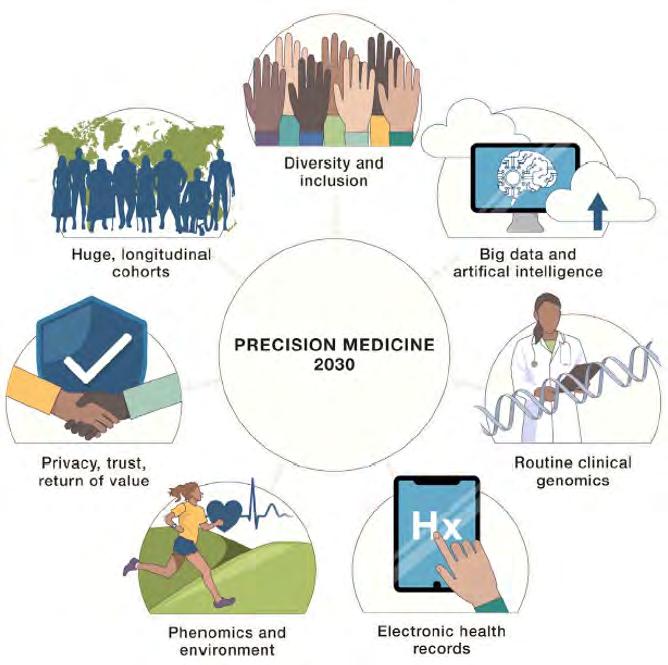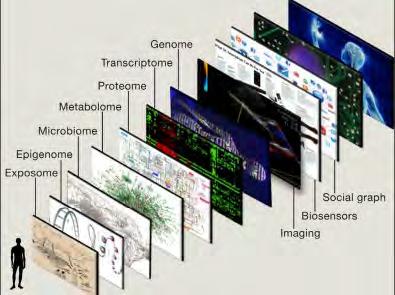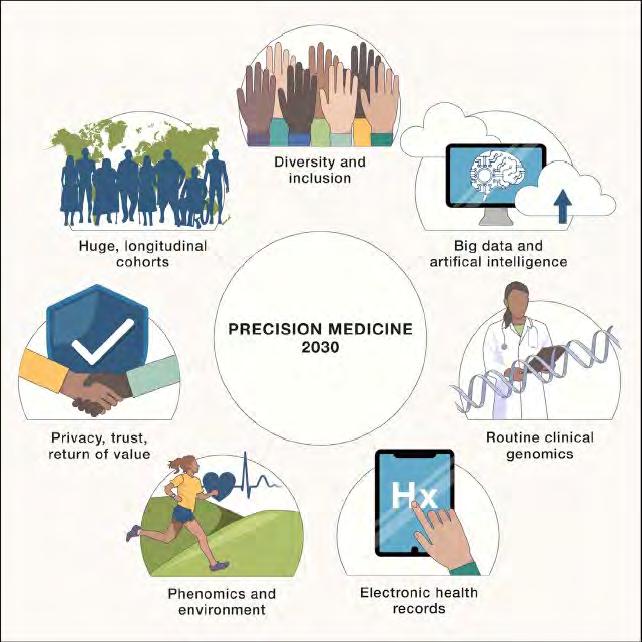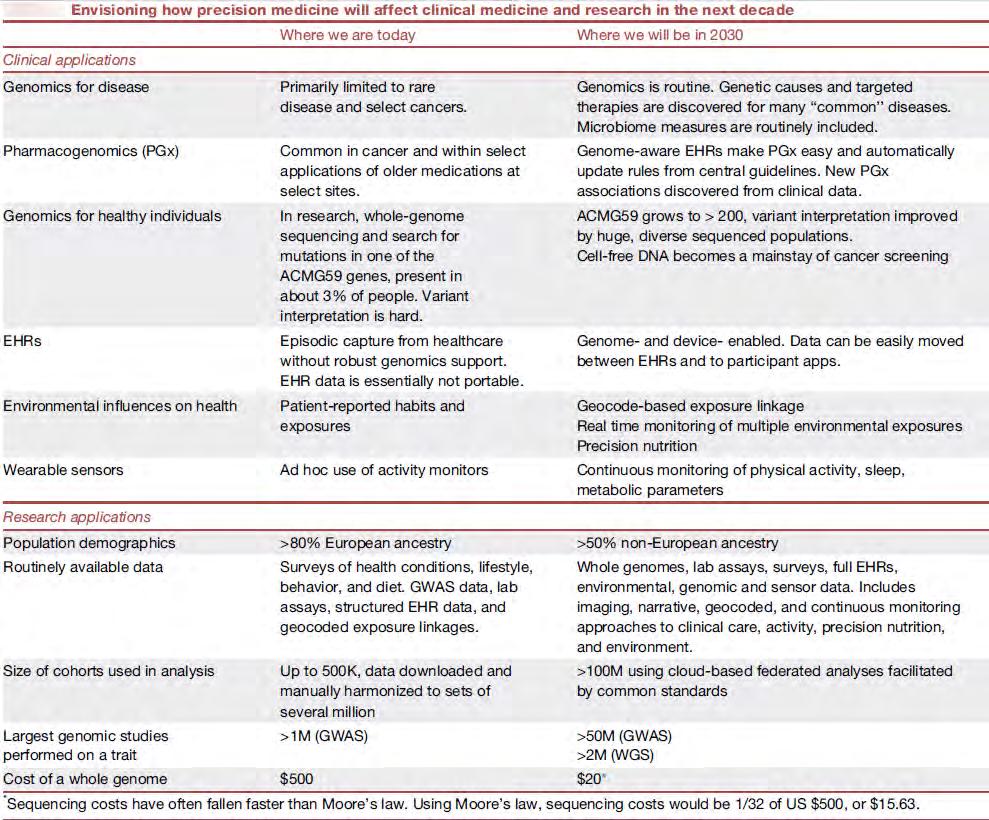
4 minute read
What are the future opportunities for SNOMED CT use?
Q4. What are the Future Opportunities for SNOMED CT Use?
FULL REPORT
SNOMED CT
Future Value
Personalized, Precision Medicine 2030
1. Huge Interoperable Longitudinal Cohorts - Over the last 20 years, national cohorts (e.g. UK Biobank), have amassed huge populations with genomic, laboratory, and lifestyle assessments as well as longitudinal follow-up on health outcomes. The breadth and depth of data is staggering, as is the opportunities for discovery.
2. Diversity and Inclusion - With a growing depth of data, we have an opportunity to replace adjustments for race and ethnicity with more specific measures.
3. Big Data and AI - AI approaches in medicine have been limited by the (un)availability of large, commonly structured datasets. Looking forward, biomedical datasets will become increasingly ready for analyses.
4. Routine Clinical Genomics – Moving forward, whole genome approaches will become a routine, early step in the understanding, prevention, detection, and treatment of common and rare diseases.
5. Electronic Health Records – Many site-based and national research cohorts now use EHRs and other health data to provide up to decades of disease and treatment information that can be repurposed for research. This use will continue to expand.
6. Phenomics and Environment – Continued growth of research and clinical uses for different ways to measure clinical phenotypes, exposures, and lifestyles.
7. Privacy, Trust and Return of Value - The utility of precision medicine is dependent on broad participation, and broad participation of large populations requires trust, protection of privacy, and a return of value to the participants.8
The healthcare industry is ever evolving. The future opportunities for SNOMED CT will be driven by new healthcare data sources and new healthcare technologies.
From a health care industry-wide perspective the following new data sources and technologies are seen as significant.
FULL REPORT
The healthcare industry is ever evolving. The future opportunities for SNOMED CT will be driven by new healthcare data sources and new healthcare technologies.
From a health care industry-wide perspective the following new data sources and technologies are seen as significant.
New Data Sources
New Technologies
1
SNOMED CT –embedded Clinical Information Systems, Health Data & Analytics Platforms and Interoperability Solutions New Data Sources – unstructured-to-structured data, “omics” data.
New Technologies – machine learning, artificial intelligence, deep learning, blockchain, biosensors, advanced semantic interoperability, differential privacy, quantum computing6 .
However, ‘omics’ data coupled with artificial intelligence, machine learning, deep learning and other technologies are drawing the most attention globally given their contribution to the field of
personalized, precision medicine.
Q4. What are the Future Opportunities for SNOMED CT Use?
Personalized, Precision Medicine
The ability to digitize the medical essence of a human being is predicated on the integration of multiscale data, akin to a Google map, which consists of superimposed layers of data such as street, traffic, and satellite views. For a human being, these layers include demographics and the social graph, biosensors to capture the individual’s physiome, imaging to depict the anatomy (often along with physiologic data), and the biology from the various omics (genome-DNA sequence, transcriptome, proteome, metabolome, microbiome, and epigenome). In addition to all of these layers, there is one’s important environmental exposure data, known as the ‘‘exposome.’’7

Q4. What are the Future Opportunities for SNOMED CT Use?
Personalized, Precision Medicine 2030
1. Huge Interoperable Longitudinal Cohorts - Over the last 20 years, national cohorts (e.g. UK Biobank), have amassed huge populations with genomic, laboratory, and lifestyle assessments as well as longitudinal follow-up on health outcomes. The breadth and depth of data is staggering, as is the opportunities for discovery. 2. Diversity and Inclusion - With a growing depth of data, we have an opportunity to replace adjustments for race and ethnicity with more specific measures. 3. Big Data and AI - AI approaches in medicine have been limited by the (un)availability of large, commonly structured datasets. Looking forward, biomedical datasets will become increasingly ready for analyses. 4. Routine Clinical Genomics – Moving forward, whole genome approaches will become a routine, early step in the understanding, prevention, detection, and treatment of common and rare diseases. 5. Electronic Health Records – Many site-based and national research cohorts now use EHRs and other health data to provide up to decades of disease and treatment information that can be repurposed for research. This use will continue to expand. 6. Phenomics and Environment – Continued growth of research and clinical uses for different ways to measure clinical phenotypes, exposures, and lifestyles. 7. Privacy, Trust and Return of Value - The utility of precision medicine is dependent on broad participation, and broad participation of large populations requires trust, protection of privacy, and a return of value to the participants.8

Q4. What are the Future Opportunities for SNOMED CT Use?
FULL REPORT Personalized, Precision Medicine 2030
Personalized, precision medicine promises improved health by accounting for individual variability in genes, environment, and lifestyle. It will continue to transform healthcare in the coming decade, and beyond, as it expands in key areas: huge cohorts, artificial intelligence (AI), routine clinical genomics, phenomics and environment, and returning value across diverse populations.
SNOMED CT as a core reference clinical terminology is well-positioned the enable the semantic ‘interoperation’ and knowledge representation of massive, diverse health data sets, using advanced technologies (e.g. AI/ML), that need to be positioned for personalized, precision medicine, analytics and research.


